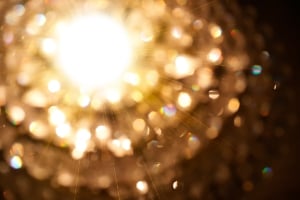 Is light the next monochrome wall to fall?
Is light the next monochrome wall to fall?
From movies to television sets and from computer monitors to cell phones, black-and-white interfaces are so last century. But, traditionally the light bulbs we use are still primarily on or off, a very binary state that looks like it could be about to break. Light is moving from on-off and some shades of grey to all the colors of the rainbow.
Back in 2012, Philips introduced its Hue "smart bulb," a light bulb with built-in wireless connectivity to the home network. It was an interesting product introduction for several reasons. First, suddenly a product as mundane as a light bulb was essentially connected to the internet. Practically anyone who could screw in a light bulb was introduced to the concept of the Internet of things. Hue bulbs have their own software development platform, and there are already hundreds of smartphone apps just for these light bulbs. It’s become an entire smart ecosystem.
Another key feature of Philips’ advanced light bulbs is their ability to produce practically any color. The light can be set to match the wallpaper, the sofa, the carpeting or an article of clothing. The bulb can even glow to set the mood depending on the time of day.
For anyone who follows the market for consumer electronics closely, it would be tempting to write off this feature as more of a gimmick than a useful function. But, the ability to choose among millions of colors can have real user benefits boosting moods and attitudes throughout the day. These modern-day LED RGB bulbs are the gift that keeps on giving, and they last a generation.
Research Capsule, a market research firm specializing in digital lifestyles, has spoken to several municipal-employed lighting experts who are actively lobbying their governments to move away from “tubes of white light” for students and city employees. Long, white florescent light bulbs are the result of a legacy infrastructure and hardly provide the ideal lighting conditions for tasks. Studies have shown that light colors should vary based on the task and subject at hand. Learning languages, math, and music are different are require different lighting conditions. New bulbs can optimize the learning environment.
Philips is not alone in bringing mood-boosting bulbs to market. A startup called LIFX has developed a popular Wi-Fi enabled, multi-colored bulb. The bulbs support sleep and wake-up habits and detailed behaviors. The company says their bulb emits a light blue light that encourages a calm and peaceful mood, and its deep blue color increases productivity and concentration. The company recommends a purple light to stimulate and relax. With millions of colors, there are many moods to choose from.
These lights are being increasingly installed in retail establishments, restaurants, as well as residences. The prices are high compared to standard LED bulbs. A LIFX bulb costs up to $100 each and Philips’ Hue colored bulbs cost around $60. But, Research Capsule estimates that the costs will come down as component prices decrease and demand increases. These are still niche products, but are quickly reaching the ordinary.
The concept of light bulbs providing on-going behavioral dividends, like music, is a new concept. But Research Capsule believes that colored light will become a key consumer electronics trend during the coming years. The technology enablers are well in place for the market to develop. The installed user base of smartphones, the connectivity chipsets and the expanding number of smart home networks will support this trend.
For more information about Smart Bulbs, checkout Research Capsules’ full report, Smart Bulbs: Reaching Towards Mainstream, Global Market for Light Bulbs to 2019.
Editor's Note:
This post was written by Peter Bryer, Co-Founder of Research Capsule.
About Research Capsule
Research Capsule was founded by industry veterans with a combined 30 years' experience in market research and forecasting. As former users of market research, the founders realize that sharp and clear messages are just as vital as the content itself. Research Capsule understands the importance of providing actionable conclusions and useful data points to clients. This is why they include clear recommendations in each report for players across the value chain.


